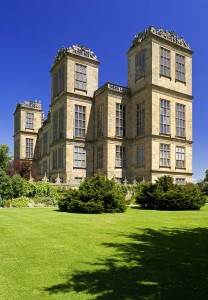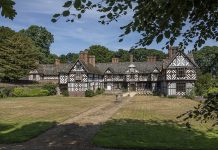
With Tudor Times we profile a different figure every month. Here, Melita Thomas looks at Elizabethan entrepreneur Bess of Hardwick, one the era’s most formidable women.

Next time you are on the M1 in Derbyshire look west to catch a glimpse of stunning Hardwick Hall. Built in the last decades of Elizabeth I’s reign, Hardwick Hall – ‘more glass than wall’ – was at the forefront of fashion. It was also a statement of wealth and position.
The builder, Elizabeth, Countess of Shrewsbury, or ‘Bess of Hardwick’, was no less remarkable than her creation. She was born around 1527, daughter of a gentleman farmer of Hardwick, who died not long after her birth, leaving his wife and children short of money.
As was customary for gentlewomen, Bess joined the household of richer relatives, Lord and Lady Zouche at Codnor Castle. While at Codnor, Bess married for the first time. Her husband, Robert Barlow, was a distant cousin, so although described as a love match, their families approved of the marriage, even though Robert was under age. Sadly, he died before reaching his majority, leaving Bess at the mercy of the heir’s guardian, who refused to pay her dower. Probably only about 16, Bess sued him – successfully – showing the determination to maintain her rights that was the cornerstone of her character.
Bess’ next move was to the house of Henry Grey, Marquess of Dorset, whose wife was the niece of King Henry VIII. Establishing a close relationship with the Dorsets, Bess was soon partaking of their social life around the court. In 1547, she married Sir William Cavendish. Once a colleague of Thomas Cromwell, Cavendish was an associate of many of the men who surrounded the new king, Edward VI, including the Duke of Northumberland and Sir William Cecil.

Now Lady Cavendish, Bess and her husband soon formed a happy working relationship, despite the 20 year or more age gap. Their shared ambition was to build a great landed estate. Over the following 10 years, they produced eight children and bought swathes of land around Chatsworth in Derbyshire.
During this period, Bess made the acquaintance of the king’s half-sisters, Ladies Mary and Elizabeth. She was of a similar age and religious outlook to Lady Elizabeth and the two were on excellent terns – Lady Elizabeth even standing as godmother to one of the Cavendish children.
On Edward VI’s death in 1553, the Dorsets, now Duke and Duchess of Suffolk, became embroiled in a failed plot to place their daughter, Lady Jane Grey, on the throne instead of Lady Mary. Bess and Cavendish were suspected of involvement, but no charges were brought and they lived quietly during Mary’s reign until in 1557, Cavendish was accused (probably with reason) of embezzlement of public funds. He died before the matter could be resolved, leaving Bess with a large debt, which, fortunately, was forgiven when Lady Elizabeth succeeded Mary.
Bess had kept in contact with the new queen throughout Mary’s reign and Elizabeth appointed her as a Lady of the Privy Chamber. In 1559, Bess married again, to Sir William St Loe, the Queen’s Captain of the Guard. St Loe was wealthy, with estates in Somerset, and the couple were deeply attached to each other, although their happiness was overshadowed by quarrels with William’s brother, Edward, who may even have tried to poison Bess.
Eight years later, St Loe died. After three years of widowhood, Bess made her most splendid match of all, to George Talbot, Earl of Shrewsbury. In a world where a woman’s wealth became her husband’s on marriage, Bess was careful to protect her interests and those of her children. It was agreed that Bess’ children, Henry and Mary Cavendish would marry Shrewsbury’s son and daughter, Grace and Gilbert. But financial prudence did not preclude affection and certainly Shrewsbury was very much in love, bemoaning how much he missed Bess ‘especially a’nights’, whenever he was at court serving the Queen.
Elizabeth believed the Shrewsburys to be one of the most loyal couples in England, and from 1569, she entrusted the guardianship of Mary, Queen of Scots to the Earl. Although initially Bess and he coped, eventually the strain of holding such a high status prisoner told on Shrewsbury’s mental and physical health, exacting a heavy toll on his marriage. While Shrewsbury could seldom leave his prisoner, Bess concentrated on developing her Cavendish estates and building a mansion at Chatsworth. Their relationship deteriorated to the point where Shrewsbury accused Bess of trying to cheat him financially, and refused to allow her to return to the marital home.
Their quarrelling became so notorious that the Queen intervened. While Shrewsbury obeyed the sovereign’s direct orders to live with his wife, he never forgave Bess for his perceived wrongs.
Meanwhile, Bess had incurred Elizabeth’s wrath after arranging a marriage for her daughter, Elizabeth Cavendish, with Lord Charles Stuart, a great-grandson of Henry VII, and potential heir to the throne. Elizabeth was furious, but eventually forgave her old friend. Lord Charles and his wife died young, leaving a daughter, Lady Arbella Stuart who, at the age of seven, came into Bess’ care.
Bess was devoted to the child, and also her prospects of inheriting the throne. She spent the 1590s (after Shrewsbury’s death) concentrating on Arbella’s education, and the creation of Hardwick Hall. But Queen Elizabeth would not name Arbella as her heir, and the strain of keeping Arbella safe from plotters told on the whole family, as the young woman sought to escape the restrictions Bess imposed. Eventually, on the accession of James VI and I, Arbella was allowed to join the court.
Bess was left in Derbyshire, where she continued to take an active interest in her estate and architecture, despite financial quarrels with her children marring her happiness. Bess was an entrepreneur – she bought up decayed estates, founded manufactories to provide materials for her building projects, and checked the smallest details in her accounts. While amassing huge wealth, she gave generously to charity and took good care of her family and staff.
Bess was, perhaps, the single most successful woman of the age – she rose from obscurity to enormous wealth, yet enjoyed her freedom and much personal happiness. Her descendants still grace the stately homes of England and HM The Queen is Bess’ 10 times great-granddaughter.







 © 2024
© 2024